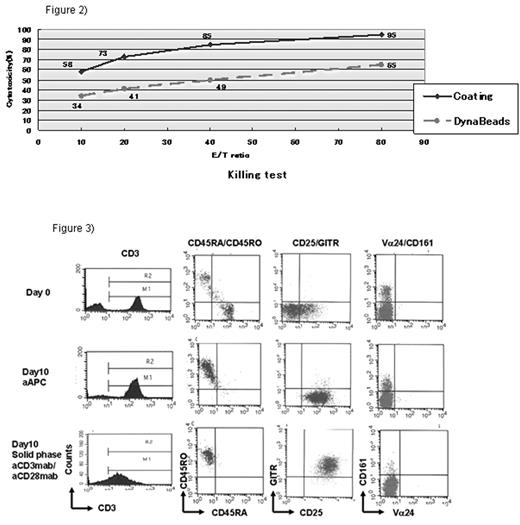Abstract
[Background] In vitro cell expansion in culture with solid phase anti-CD3-mab (aCD3mab) is a standard method for lymphocyte proliferation and activation. However, clinical trials using activated lymphocytes with this system provided only minimal efficacy. Recently, aCD3mab/aCD28mab-coated micro-bead (aAPC) was developed as a novel tool to efficiently expand lymphocytes, and has been used in several clinical trials. This study was designed to evaluate the effects of solid phase aCD3mab/aCD28mab on the proliferation and activation of lymphocytes to compare the results with culture using aAPC.
[Methods and Results] Parameters to evaluate the efficacy of culture system included magnitude of cell proliferation, killing activity against K562 and various surface markers of cultured cells. Peripheral blood was obtained from healthy volunteers after an informed consent was obtained, and mononuclear cells (PBMNc) were separated by lymphosepal system. Firstly, we cultured PBMNc in system with solid phase aCD3mab/aCD28mab coated to a culture plate (Culture A) or with solid phase aCD3mab coated to a culture plate plus soluble form aCD28mab (Culture B) to seek an optimal condition in the solid phase for lymphocyte proliferation (Figures 1). The results showed that the optimal ratio of aCD3mab:aCD28mab for Culture A is 3:7 to yield fold-expansion of lymphocytes of 12–13, while this in Culture B with the same amount of monoclonal antibodies was 10 (n=6). There was no difference in the expression CD3, CD4 or CD8, and killing activity between expanded cells in Culture A and Culture B. Then, we compared optimized solid phase Culture A with liquid phase culture with aAPC (Culture C). As a result, cell proliferation in Culture A was 1.3–5.6 times higher and the killing activity was 1.1–1.8 times higher than Culture C (Figure 2). In Culture A, the cell expression of CD45RO and GITR was higher and that of CD161 was lower compared to Culture C (Figures 3). Solid phase culture system with aCD3mab/aCD28mab is efficient and easily applicable for the expansion of lymphocytes, however more detail characterization of the expanded cells, especially Treg function and in vivo survival, are necessary.
Disclosure: No relevant conflicts of interest to declare.
Author notes
Corresponding author



This feature is available to Subscribers Only
Sign In or Create an Account Close Modal